Vermont Journal Day 3: Touring the Farms
So, lesson one I learned on this trip, sleeping in nearly 90 degree weather without any air conditioning is…challenging. If you ever want to experience it, go to Barrett Hall or any other freshman dorm at William and Mary during the dead of summer, lock yourself into a room, open the windows with a fan, and try to sleep. Trust me, it’s not very pleasant.
However, lesson two I learned on this trip was what was pleasant: the staff here at the Inn. When they say that they will do their best to try to make your visit the most comfortable, they absolutely mean it. I went through today and watched as they literally managed to somehow move everyone that was on the highly uncomfortable 3rd floor (heat rises, remember) to the 2nd floor, while at the same time accounting for the guests who had already booked their rooms on that floor. So while at the beginning of the day, I found myself in a small, overheated corner room of the inn, tonight, I find myself writing to you from the “Empire Room” of the estate.
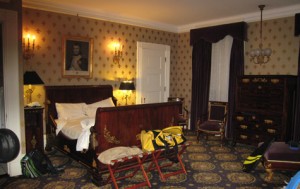
The Empire Room at Shelburne Farms used to house VIP guests of the Webbs back in the day. Guests included the likes of Teddy Roosevelt and Admiral Dewey.
The Empire Room, in a word, is gorgeous, in all honesty, all of the guest rooms on the 2nd floor of the inn are. In olden days, whereas the small, double bed rooms like the Red Room and Cherry Room were reserved solely for the bachelors, rooms like the Empire Room on the 2nd floor were generally reserved for VIP guests who were staying at the Shelburne Farms estate. According to the pamphlet provided, such VIP guests included the likes of Lila Vanderbilt’s mother, Maria Vanderbilt (daughter-in-law to Cornelius Vanderbilt, the famous railroad entrepreneur), Teddy Roosevelt, and Admiral Dewey.
I don’t know about you, but it makes me feel a bit special that I may be staying in a room that Teddy Roosevelt stayed in almost 130 years ago…
Each room on the second floor is also interesting in that it is adorned with a specific theme.
For example, the Empire Room where I currently am on the bed writing from is decorated with a theme of royalty that was made popular by Napoleon in the late 19th century. Thus, the wallpaper in the room looks like a royal crest while the fireplace is adorned with columns and goddesses. Adjacent to my room, where my parents were moved to, was the Louis XVI Room, which literally looks like a room out of the Versailles Palace.
Hopefully, things will be a bit cooler down here, which I can already feel they are.
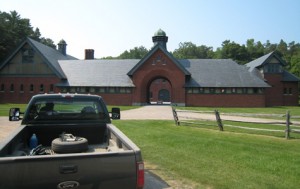
The Webbs loved carriage rides, as can be attested by the Coach Barn in Shelburne Farms, a two story structure that used to house more than 30 carriages back in the day.
The rest of today was spent touring the other buildings on the farm and learning more about the history of the farm itself.
Yesterday, I explained that Shelburne Farms was a haven for the rich to get away from the city. But, as always, there’s much more to the story than just that. After Lila Vanderbilt’s father passed away, he wanted to ensure that there were no estate disputes after his death like his father, Cornelius Vanderbilt has caused due to favoritism among his sons. To prevent such disputes, Lila’s father decided to evenly split up his estate among all of his sons and daughters all of which, he thought, deserved part of the Vanderbilt fame. Thus, Lila came to acquire several million dollars by which Shelburne Farms was funded. The location for the farms themselves were chosen when William Seward Webb, scouting out properties for the Vanderbilt railcar company, fell in love with the land that ultimately became the town of Shelburne, VT. Thus, Shelburne Farms was born.
From the very beginning, Webb’s mission for the farms was to create a “model farm” by which other farms could follow in the footsteps of. As a model farm, Shelburne needed to be the pinnacle of greatness, both in aesthetics as well as the practical.
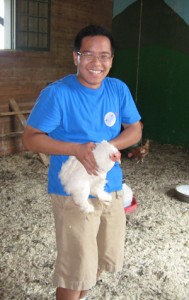
The farm represents the pinnacle of sustainable farming. 70 percent of foods cooked at the inn consist of ingredients grown or raised on the farm. (Unfortunately, I think I scared the living daylights out of this chicken...)
Thus, we see a farm whose buildings were designed by the famous architect Robert H. Robertson, known for his eyebrow windows, and landscaping done by Fredrick Olmstead, creator of Central Park in New York. We see that Robertson incorporated all architectural styles in his planning, while at the same time accounting for location and pragmatism.
We also see pastures and fields designed by Olmstead to always please the
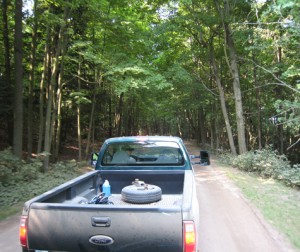
The Rambling, a similar one of which also is in New York's Central Park, is an example of how Olmstead used forestry to provide both an aesthetic and a practical use on Shelburne Farms. Here, the cool undergrowth lowers the temperature on a hot day by nearly 10 degrees.
eye and give the look of rolling pastures. As our tour guide said today, “nothing is linear, no direct line from A to B, everything is curved to give the illusion that there’s always something more to be seen.” Like Central Park, Olmstead also realized the great potential that tress serve in the soil and the aesthetic beauty that simple “islands” of tress could bring to a pasture to make it greener.
But the farms themselves have not had an easy time through the ages. During the early 20th century, the establishment of the income tax and the estate tax made it so that by the 1950s, upkeep of the farm with its large acreage was almost impossible to maintain. Alec Webb, current President of the Shelburne Farms Board of Directors, remembers one 1950s day where their father brought the whole family to the South Porch of the house to discuss the possibility of selling off the land.
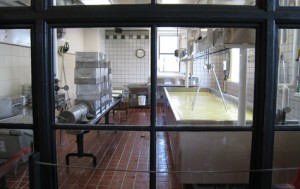
The farm's main output consists of a cheddar cheese made from the milk of hundreds of cows that can be seen at all times of days on the pasture. But don't expect to find these cheeses at your local Kroger's.
But due to the fact that most of the family members were opposed to the idea, Shelburne Farms was able to continue to grow into what it is today: a farm that produces some of the best cheddar cheese in Vermont, and arguably in all of New England, but also a teaching and learning center for safe and ecologically friendly agricultural practices.
In my opinion, it’s nice to see a farm for once that isn’t entirely bent on profits. All too often nowadays, and more significantly with the recession, I feel like today’s world focuses too much on quota and cost, especially in the agricultural world where prices are constantly fluctuating. I think it’s great that someone out there is finally taking a step back and quite frankly asking ourselves: what exactly are we doing to this Earth, and in what ways can we live with mother nature, not live because of mother nature.




No comments.
Comments are currently closed. Comments are closed on all posts older than one year, and for those in our archive.